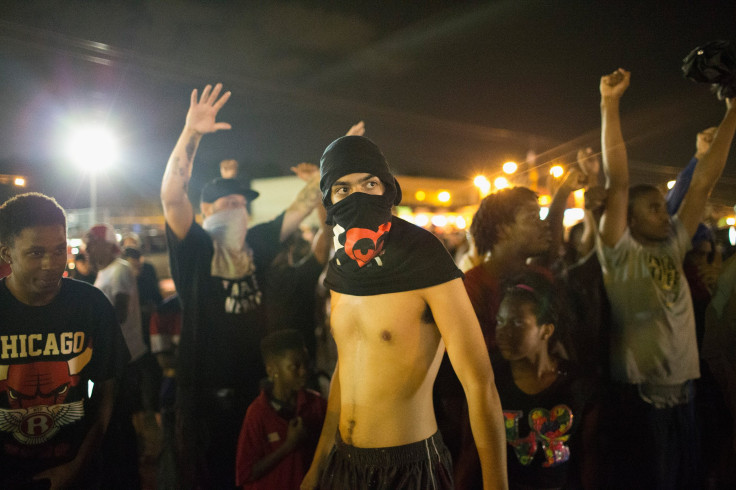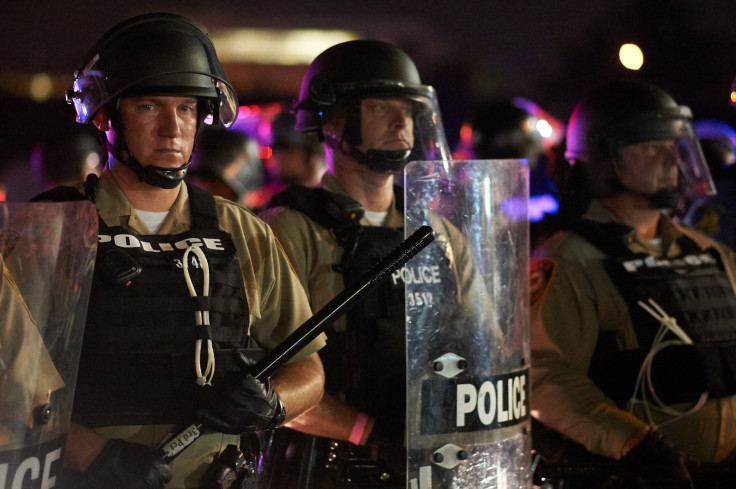Ferguson Residents Wary After Peaceful Night Protests Turn Violent

Patricia Bynes wanted to honor the life of Michael Brown, the teenager killed by a white police officer in 2014 whose death prompted a national debate on race and police brutality. Bynes, a Democratic committee member of Ferguson Township, attended church on Sunday and then headed to what was supposed to be a peaceful protest and vigil commemorating the one-year anniversary of Brown's death in downtown Ferguson, Missouri. But by the time she arrived, the demonstration had turned to panic and violence as police officers traded gunshots with a protester and people fled the scene in fear.
"It's frustrating. People worked so hard to make things peaceful, and another group of people decided to make it (the protests) into something else, on the very day Michael Brown died," said Bynes. "Last year, people were not shooting at each other during the protest. These are criminals wanting to take advantage of the protests."
Many Ferguson residents had looked forward to a day of peaceful protests on Sunday to mark the anniversary of Brown’s death, which led to weeks of anti-police protests in Ferguson and across the nation. Instead, as the celebration of his life was gripped by violence, one protester threw a rock through a business window, shattering not only the storefront’s glass but also the hopes of many Ferguson residents that the city had moved forward after a year of racial tensions and anger.
“It continues to be disheartening and frustrating to wake up to accounts of violence in general, police-involved shootings and vandalism,” said Pastor Willis Johnson of Wellspring Church in Ferguson. “Men and women, community folks have been interested in direct action for respectful and responsible forms of civil disobedience, and a very small, select set of individuals with an agenda that is not purposeful or meaningful, make (the protests) dangerous and derail the overall aim and message that many of those gatherings are about. That in itself is getting old; it’s getting tiresome.”
During the protest Sunday, three people were shot, including a friend of Brown’s, Tyrone Harris Jr., 18, who was in critical condition Monday, and four people were arrested. After police declared the protest no longer peaceful, officers in riot gear and armored vehicles filled the streets. "I strongly condemn the violence against the community, including police officers, in Ferguson, Missouri," tweeted U.S. Attorney General Loretta Lynch Monday.

The overall message of the protesters, who have called for economic and racial justice, is important, said the Rev. Steve Lawler of St. Stephens Episcopal Church in Ferguson. Ferguson for decades has struggled with racial and social issues in a city where a majority black population is led by a majority white government, and those issues had manifested themselves in Brown’s death, Lawler said. A recent Department of Justice investigation found that Ferguson police targeted black residents for years.
Before the shots rang out Sunday, it seemed at first that peace had finally come to Ferguson, Lawler said. Police were less confrontational and protestors were much more organized, communicating with law enforcement more effectively. During the protests immediately following Brown's death, police were criticized for confronting demonstrators with tanks and riot gear.
I strongly condemn the violence against the community, including police officers, in Ferguson, Missouri.
— AG Loretta Lynch (@LorettaLynch) August 10, 2015A demonstration planned for Monday was also aimed at closing the inequality gap between black and white Ferguson residents. But after the violence on Sunday, some were worried that message would again be overshadowed by confrontations with police and demonstrators.
“I’m hopeful the protests will be active and nonviolent, but I’m wary because I felt the same during the grand jury indictment and that’s not what happened,” said Scott Bonner, the director of Ferguson’s public library, who watched Sunday night’s protests unfold on social media. “Long-term, Ferguson will come together; it has to. When people have a common cause, they come together.”
© Copyright IBTimes 2024. All rights reserved.






















